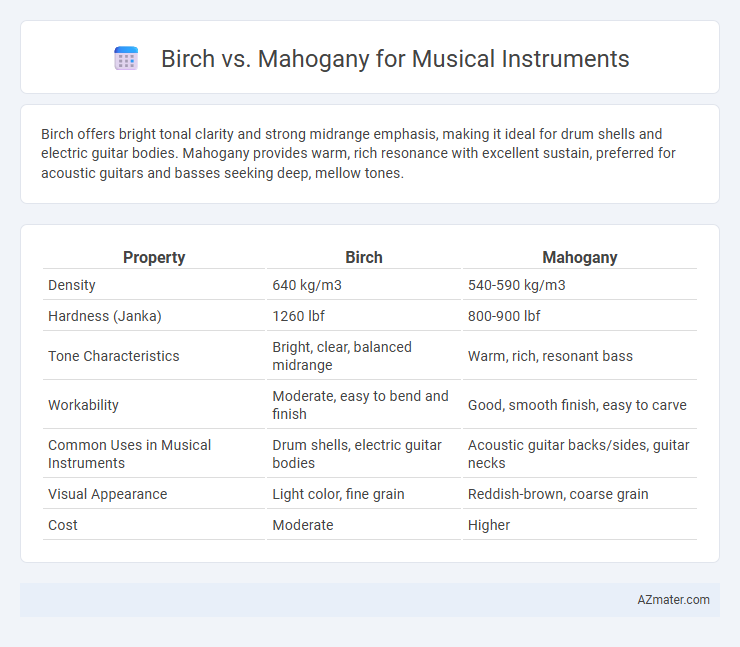Birch offers bright tonal clarity and strong midrange emphasis, making it ideal for drum shells and electric guitar bodies. Mahogany provides warm, rich resonance with excellent sustain, preferred for acoustic guitars and basses seeking deep, mellow tones.
Table of Comparison
| Property | Birch | Mahogany |
|---|---|---|
| Density | 640 kg/m3 | 540-590 kg/m3 |
| Hardness (Janka) | 1260 lbf | 800-900 lbf |
| Tone Characteristics | Bright, clear, balanced midrange | Warm, rich, resonant bass |
| Workability | Moderate, easy to bend and finish | Good, smooth finish, easy to carve |
| Common Uses in Musical Instruments | Drum shells, electric guitar bodies | Acoustic guitar backs/sides, guitar necks |
| Visual Appearance | Light color, fine grain | Reddish-brown, coarse grain |
| Cost | Moderate | Higher |
Introduction: Birch vs Mahogany in Instrument Crafting
Birch and mahogany are commonly used tonewoods in musical instrument crafting, each offering distinct acoustic properties and aesthetic qualities. Birch provides a bright, punchy sound with excellent midrange clarity, making it ideal for drum shells and electric guitar bodies. Mahogany delivers warm, rich tones with enhanced sustain and resonance, favored in acoustic guitars and high-end electric instruments.
Overview of Birch and Mahogany Wood Properties
Birch offers a bright, clear tone with strong midrange response and excellent durability, making it a popular choice for electric guitar bodies and drums. Mahogany is prized for its warm, resonant sound with rich low-mid frequencies and smooth sustain, commonly used in acoustic guitars and high-end instruments. Both woods provide different tonal qualities and weight, with birch being denser and brighter, while mahogany offers a softer, more rounded sound profile.
Tonal Characteristics: Sound Differences
Birch produces a bright, clear sound with strong midrange presence and excellent attack, making it ideal for drum shells and acoustic guitar bodies where clarity and projection are desired. Mahogany offers a warmer, richer tone with enhanced low-mid frequencies and a softer attack, favored for its smooth, resonant qualities in electric guitars and acoustic instruments. The tonal differences between birch and mahogany significantly affect the instrument's sound profile, with birch focusing on brightness and definition, while mahogany emphasizes warmth and depth.
Weight and Density Comparison
Birch wood, with a density ranging from 600 to 700 kg/m3, tends to be lighter and less dense compared to mahogany, which typically has a density between 530 and 850 kg/m3 depending on the species. This variation makes birch instruments more manageable in weight, offering greater comfort during extended play sessions while mahogany's higher density contributes to enhanced resonance and warmth in sound. Choosing between birch and mahogany involves balancing the lighter weight and bright tonal qualities of birch against the heavier, richer acoustic properties of mahogany.
Workability and Durability for Luthiers
Birch offers excellent workability for luthiers due to its fine, even grain, allowing precise shaping and easy sanding, making it ideal for detailed instrument parts. Mahogany boasts superior durability with its dense, stable fibers, providing resilience against wear and environmental changes, which enhances the longevity of musical instruments. While birch facilitates efficient crafting, mahogany ensures sustained performance and strength, making both woods valuable depending on the specific requirements of the instrument.
Aesthetic Qualities: Grain and Appearance
Birch features a fine, even grain with a pale, almost maple-like appearance that offers a clean and modern aesthetic ideal for instruments requiring a bright visual appeal. Mahogany displays a rich, warm reddish-brown hue with a straight, often interlocked grain pattern that deepens in color over time, providing a classic and luxurious look favored in traditional and vintage-style instruments. The visual contrast between birch and mahogany helps musicians select wood based on desired instrument character, combining tonal properties with distinctive grain and color preferences.
Birch and Mahogany in Popular Instruments
Birch wood is commonly used in drum shells due to its bright tone and strong projection, favored in brands like DW and Yamaha for delivering crisp, articulate sound. Mahogany, preferred in acoustic guitars such as Gibson models, offers warm, rich resonance and enhanced sustain, making it ideal for genres needing deep, mellow tones. Both woods significantly influence the tonal character and aesthetic appeal of popular musical instruments, impacting performance and recording quality.
Price and Availability of Birch vs Mahogany
Birch wood offers a more affordable alternative to mahogany, making it popular among beginner and mid-range musical instrument manufacturers. Birch is widely available in North America, which contributes to its lower price and ease of sourcing compared to mahogany, which is often imported and subject to stricter regulations. Mahogany commands a higher price due to its prized tonal qualities and limited, sustainable harvesting practices, resulting in less availability in the market.
Sustainability and Environmental Impact
Birch and mahogany differ significantly in sustainability and environmental impact for musical instruments. Birch, often sourced from fast-growing, renewable forests, supports ecological balance with lower deforestation risks and reduced carbon footprints. In contrast, mahogany, particularly from tropical rainforests, faces overharvesting concerns, habitat loss, and stricter regulations to prevent illegal logging, making birch a more eco-friendly choice for sustainable instrument manufacturing.
Choosing the Right Wood for Your Musical Needs
Birch offers a bright, punchy tone with strong midrange presence, making it ideal for electric guitars and drum shells that require clarity and projection. Mahogany provides warm, rich, and resonant sound qualities favored in acoustic guitars and string instruments, enhancing sustain and depth. Selecting birch or mahogany depends on the desired tonal character and instrument type, balancing brightness versus warmth to match your musical style and performance setting.

Infographic: Birch vs Mahogany for Musical Instrument
 azmater.com
azmater.com